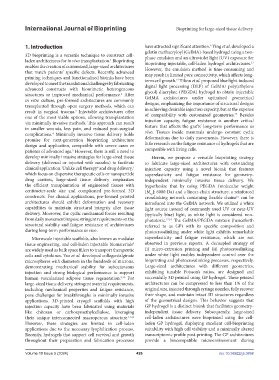Page 434 - IJB-10-5
P. 434
International Journal of Bioprinting Bioprinting for large-sized tissue delivery
1. Introduction have attracted significant attention. Ying et al. developed a
6
gelatin methacryloyl (GelMA)-based hydrogel using a two-
3D bioprinting is a versatile technique to construct cell- phase emulsion and an ultraviolet light (UV) exposure for
1
laden architectures for in vivo transplantation. Bioprinting bioprinting injectable, cell-laden hydrogel architectures.
13
enables the creation of customized, large-sized architectures However, the emulsion method is time-consuming and
that match patients’ specific defects. Recently, advanced may result in limited pore connectivity, which affects long-
printing techniques and functionalized bioinks have been 14
developed to meet the translational challenges by fabricating term cell growth. Tilton et al. proposed blue light-induced
advanced constructs with biomimetic heterogeneous digital light processing (DLP) of GelMA/ poly(ethylene
2
structures or improved mechanical performance. After glycol) diacrylate (PEGDA) hydrogel to obtain injectable
in vitro culture, pre-formed architectures are commonly GelMA architectures under optimized geometrical
transplanted through open surgery methods, which can designs, emphasizing the importance of structural designs
in achieving desirable injection capacity, but at the expense
3
result in surgical trauma. Injectable architectures offer of compatibility with customized geometries. Besides
15
one of the most viable options, allowing transplantation
via minimally invasive methods. This approach can result injection capacity, fatigue resistance is another critical
in smaller wounds, less pain, and reduced post-surgical feature that affects the grafts’ long-term performance in
complications. Minimally invasive tissue delivery holds vivo. Tissues inside mammals undergo constant cyclic
4
promise for next-generation bioprinting architecture deformations due to daily movements. However, there is
design and application, compatible with severe cases or little research on the fatigue resistance of hydrogels that are
patients of advanced age. However, there is still a need to compatible with living cells.
5
develop minimally invasive strategies for large-sized tissue Herein, we propose a versatile bioprinting strategy
delivery (delivered or injected with nozzles) to facilitate to fabricate large-sized architectures with outstanding
clinical application. Unlike cell therapy and drug delivery, injection capacity using a novel bioink that features
6
7
which focus on dispersive therapeutic cells or nanoparticle superelasticity and fatigue resistance for geometry-
drug carriers, large-sized tissue delivery emphasizes independent minimally invasive tissue delivery. We
the efficient transplantation of engineered tissues with hypothesize that by using PEGDA (molecular weight
centimeter-scale size and complicated pre-formed 3D [M ]: 6000 Da) and a linear-chain structure, a reinforced
w
constructs. For clinical applications, pre-formed printed crosslinking network containing flexible chains can be
16
architectures should exhibit deformation and recovery introduced into the GelMA network. We utilized a white
capabilities to maintain structural integrity after tissue light source instead of commonly used UV or near-UV
delivery. Moreover, the cyclic mechanical forces resulting (typically blue) light, as white light is considered non-
from daily movement impose stringent requirements on the phototoxic. 17,18 The GelMA/PEGDA mixture (henceforth
structural stability and fatigue resistance of architectures referred to as GP) with its specific composition and
during long-term performance in vivo. photocrosslinking under white light exhibits remarkable
Microscale injectable scaffolds, also known as modular superelasticity and fatigue resistance, which are not
tissue engineering, and cell-laden injectable biomaterials observed in previous reports. A decoupled strategy of
8
are widely used as bulk space fillers to transport therapeutic (i) micro-extrusion printing and (ii) photocrosslinking
cells and cytokines. Yao et al. developed collagen/alginate under white light enables independent control over the
microspheres with diameters in the hundreds of microns, bioprinting and photocrosslinking processes, respectively.
demonstrating mechanical stability for subcutaneous Large-sized architectures with different geometries,
injection and strong biological performance to support exhibiting tunable Poisson’s ratios, are designed and
9,10
human vascularized adipose tissue regeneration. For successfully 3D printed using GP hydrogel. These printed
large-sized tissue delivery, stringent material requirements, architectures can be compressed to less than 1% of the
including mechanical properties and fatigue resistance, original size, injected through syringe nozzles, fully recover
pose challenges for breakthroughs in minimally invasive their shape, and maintain intact 3D structures regardless
applications. 3D-printed cryogel scaffolds with high of the geometrical designs. This behavior suggests that
injection capacity have been fabricated using materials GP hydrogel is a distinct bioink that facilitates geometry-
like chitosan or carboxymethylcellulose, leveraging independent tissue delivery. Subsequently, large-sized
their unique interconnected macroporous structure. 11,12 cell-laden architectures were bioprinted using the cell-
However, these strategies are limited in cell-laden laden GP hydrogel, displaying excellent cell-bioprinting
applications due to the necessary lyophilization process. suitability with high cell viability and a minimally altered
Recently, hydrogels that support cell survival and growth transcriptomic profile post-printing. The GP architectures
throughout their preparation and fabrication processes provide a biocompatible microenvironment during
Volume 10 Issue 5 (2024) 426 doi: 10.36922/ijb.3898

